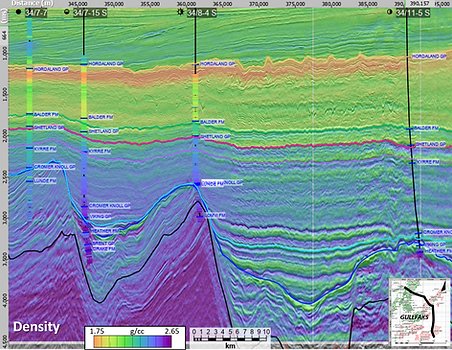Contact person: Vita Kalashnikova
Rune Inversion (April 2019) - Artificial Intelligence
The very first seismic Post-Stack Inversion algorithm that allows to estimate Velocity and Density independently; possibly, with no well logs data required! Inverted Density and Velocity used as a base for Vclay, Porosity and Reservoir quality attribute - (1-Vclay)*Phi computations.
Read theory here.
The algorithm was developed to utilise big volumes of seismic data that are publicly available on the Norwegian continental shelf in only the post-stack version. It helped to efficiently process mega grids (merged seismic surveys) to rock properties of P-wave velocity, density, the volume of clay, best quality sands and porosity, see example here.
The Rune Inversion algorithm in the process of independent P-wave velocity (Vp) and Density search:
What is the difference between conventional seismic inversion and Rune Inversion?
-
An important unresolved aspect in the seismic inversion of all known algorithms is the determination of the absolute non-coupled velocity and density. Such rock properties restoration within the developed physics and the known solution's directions remains impossible. The accurate density estimation leads to saturation prediction.
-
PSS-Geo Developed AI-driven seismic inversion approach that is based on a global optimisation algorithm and constraints and allows an estimation of the rocks' non-coupled P-wave, S-wave, and density. The approach applies to both post-stack and pre-stack seismic data. The first case results in P-wave velocity and density, and it requires seismic reflected signal simulation. The second case adds an estimation of the S-wave velocity and uses the real seismic reflected signals. The P-wave velocity can be computed as a full band compared to the FWI, which is computationally extensive and, therefore, of a limited band. Also, FWI does not resolve for density, while the proposed algorithm does.
-
To predict fluid, especially for post-stack data cases, we use Machine Learning algorithms - learning at the wells' target parameter, Saturation, at the particular formation and recognising the target parameter at seismic and derivatives volumes.
Rune Inversion post-stack seismic result: P-wave velocity and Density
The example below shows a random line from the Elephant project Tampen-Tjalve area, the Norwegian continental shelf, North Sea.
P-wave velocity and Density are the results of the post-stack Rune Inversion. The inversion can be run to full time section.
Inverted Density and Velocity used as a base for Vclay, Porosity and Reservoir quality attribute - (1-Vclay)*Phi computations.


The inverted P-wave velocity and Density are used as a base for Volume of Clay computation, Porosity and Best Reservoir Sands attribute computations. These computation must be adjusted for different formation. Below is a result with approximate valid data window. Read theory here for Vclay computation.


Public vintage data.
Example 1
Cross-seismic time section going through the oil&gas well 35/11-23 NPD fact page. Data was deghosted prior to inversion.
Jurassic sands are standing out on reservoir quality attribute - yellow color, about 2.1s.
Example 2
Cross-seismic time section going through the AErfugl and Skarv oil&gas fields. NPD fact page.
Sands are standing out on reservoir quality attribute.


